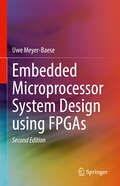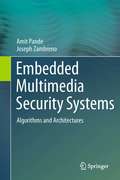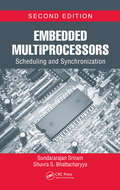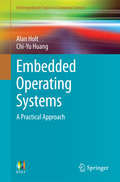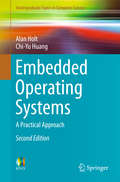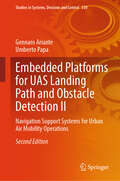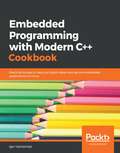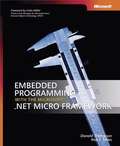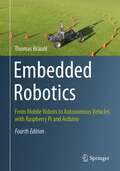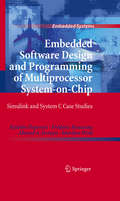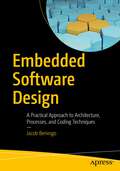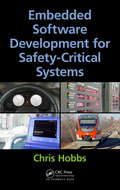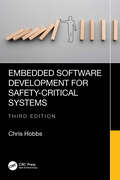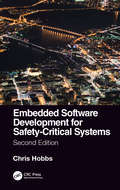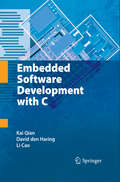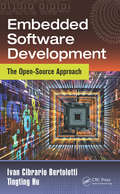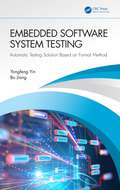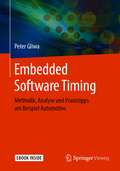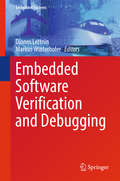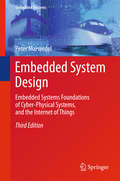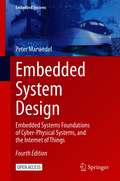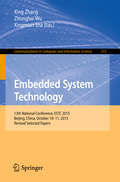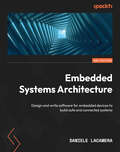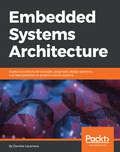- Table View
- List View
Embedded Microprocessor System Design using FPGAs
by Uwe Meyer-BaeseThis textbook for courses in Embedded Systems introduces students to necessary concepts, through a hands-on approach. It gives a great introduction to FPGA-based microprocessor system design using state-of-the-art boards, tools, and microprocessors from Altera/Intel® and Xilinx®. HDL-based designs (soft-core), parameterized cores (Nios II and MicroBlaze), and ARM Cortex-A9 design are discussed, compared and explored using many hand-on designs projects. Custom IP for HDMI coder, Floating-point operations, and FFT bit-swap are developed, implemented, tested and speed-up is measured. New additions in the second edition include bottom-up and top-down FPGA-based Linux OS system designs for Altera/Intel® and Xilinx® boards and application development running on the OS using modern popular programming languages: Python, Java, and JavaScript/HTML/CSSs. Downloadable files include all design examples such as basic processor synthesizable code for Xilinx and Altera tools for PicoBlaze, MicroBlaze, Nios II and ARMv7 architectures in VHDL and Verilog code, as well as the custom IP projects. For the three new OS enabled programing languages a substantial number of examples ranging from basic math and networking to image processing and video animations are provided. Each Chapter has a substantial number of short quiz questions, exercises, and challenging projects.
Embedded Multimedia Security Systems
by Joseph Zambreno Amit PandeOpening with a detailed review of existing techniques for selective encryption, this text then examines algorithms that combine both encryption and compression. The book also presents a selection of specific examples of the design and implementation of secure embedded multimedia systems. Features: reviews the historical developments and latest techniques in multimedia compression and encryption; discusses an approach to reduce the computational cost of multimedia encryption, while preserving the properties of compressed video; introduces a polymorphic wavelet architecture that can make dynamic resource allocation decisions according to the application requirements; proposes a light-weight multimedia encryption strategy based on a modified discrete wavelet transform; describes a reconfigurable hardware implementation of a chaotic filter bank scheme with enhanced security features; presents an encryption scheme for image and video data based on chaotic arithmetic coding.
Embedded Multiprocessors: Scheduling and Synchronization, Second Edition (Signal Processing and Communications)
by Shuvra S. Bhattacharyya Sundararajan SriramTechniques for Optimizing Multiprocessor Implementations of Signal Processing ApplicationsAn indispensable component of the information age, signal processing is embedded in a variety of consumer devices, including cell phones and digital television, as well as in communication infrastructure, such as media servers and cellular base stations. Multiple programmable processors, along with custom hardware running in parallel, are needed to achieve the computation throughput required of such applications. Reviews important research in key areas related to the multiprocessor implementation of multimedia systemsEmbedded Multiprocessors: Scheduling and Synchronization, Second Edition presents architectures and design methodologies for parallel systems in embedded digital signal processing (DSP) applications. It discusses application modeling techniques for multimedia systems, the incorporation of interprocessor communication costs into multiprocessor scheduling decisions, and a modeling methodology (the synchronization graph) for multiprocessor system performance analysis. The book also applies the synchronization graph model to develop hardware and software optimizations that can significantly reduce the interprocessor communication overhead of a given schedule.Chronicles recent activity dealing with single-chip multiprocessors and dataflow modelsThis edition updates the background material on existing embedded multiprocessors, including single-chip multiprocessors. It also summarizes the new research on dataflow models for signal processing that has been carried out since the publication of the first edition.Harness the power of multiprocessorsThis book explores the optimization of interprocessor communication and synchronization in embedded multiprocessor systems. It shows you how to design multiprocessor computer systems that are streamlined for multimedia applications.
Embedded Operating Systems
by Alan Holt Chi-Yu HuangThis practically-oriented textbook provides a clear introduction to the different component parts of an operating system and how these work together. The easy-to-follow text covers the bootloader, kernel, filesystem, shared libraries, start-up scripts, configuration files and system utilities. The procedure for building each component is described in detail, guiding the reader through the process of creating a fully functional GNU/Linux embedded OS. Features: presents a concise overview of the GNU/Linux system, and a detailed review of GNU/Linux filesystems; describes how to build an embedded system to run on a virtual machine, and to run natively on an actual processor; introduces the concept of the compiler toolchain, demonstrating how to develop a cross toolchain so that programs can be built on a range of different architectures; discusses the ARM-based platforms BeagleBone and Raspberry Pi; explains how to build OpenWRT firmware images for OMxP Open-mesh devices and the Dragino MS14 series.
Embedded Operating Systems
by Alan Holt Chi-Yu HuangThis easy-to- follow textbook/reference guides the reader through the creation of a fully functional embedded operating system, from its source code, in order to develop a deeper understanding of each component and how they work together. The text describes in detail the procedure for building the bootloader, kernel, filesystem, shared libraries, start-up scripts, configuration files and system utilities, to produce a GNU/Linux operating system. This fully updated second edition also includes new material on virtual machine technologies such as VirtualBox, Vagrant and the Linux container system Docker.Topics and features: presents an overview of the GNU/Linux system, introducing the components of the system, and covering aspects of process management, input/output and environment; discusses containers and the underlying kernel technology upon which they are based; provides a detailed examination of the GNU/Linux filesystem; explains how to build an embedded system under a virtual machine, and how to build an embedded system to run natively on an actual processor;introduces the concept of the compiler toolchain, and reviews the platforms BeagleBone and Raspberry Pi; describes how to build firmware images for devices running the Openwrt operating system.The hands-on nature and clearly structured approach of this textbook will appeal strongly to practically minded undergraduate and graduate level students, as well as to industry professionals involved in this area.
Embedded Platforms for UAS Landing Path and Obstacle Detection II: Navigation Support Systems for Urban Air Mobility Operations (Studies in Systems, Decision and Control #530)
by Umberto Papa Gennaro ArianteThis book reports on the design and development of a system that assists remote pilots during navigation. It focuses on the design and development of a ground station that assists remote pilots during maneuvers such as take-off or landing procedures, in case a high accuracy is required or the GNSS signal is lost. Continuing the tradition of the previous volume, and being its revised edition, this book covers the latest UAS regulations together with updated strategies for finding the best and safest trajectory and landing site, with a special focus on urban air mobility applications. It describes the system’s components, such as the LiDAR sensor, the temperature and humidity sensors, the Raspberry Pi 3 controller, and the Bluetooth Low Energy Transmitter, in detail. Further, it discusses the experimental tests carried out in both controlled laboratory settings and real-world environments. All in all, this book offers a timely survey of both regulations of and electronics design for unmanned aircraft systems, with extensive information on new methods and technologies for the development of Detect and Avoid systems for unmanned aerial vehicles.
Embedded Programming with Modern C++ Cookbook: Practical recipes to help you build robust and secure embedded applications on Linux
by Igor ViarheichykExplore various constraints and challenges that embedded developers encounter in their daily tasks and learn how to build effective programs using the latest standards of C++ Key Features Get hands-on experience in developing a sample application for an embedded Linux-based system Explore advanced topics such as concurrency, real-time operating system (RTOS), and C++ utilities Learn how to test and debug your embedded applications using logs and profiling tools Book Description Developing applications for embedded systems may seem like a daunting task as developers face challenges related to limited memory, high power consumption, and maintaining real-time responses. This book is a collection of practical examples to explain how to develop applications for embedded boards and overcome the challenges that you may encounter while developing. The book will start with an introduction to embedded systems and how to set up the development environment. By teaching you to build your first embedded application, the book will help you progress from the basics to more complex concepts, such as debugging, logging, and profiling. Moving ahead, you will learn how to use specialized memory and custom allocators. From here, you will delve into recipes that will teach you how to work with the C++ memory model, atomic variables, and synchronization. The book will then take you through recipes on inter-process communication, data serialization, and timers. Finally, you will cover topics such as error handling and guidelines for real-time systems and safety-critical systems. By the end of this book, you will have become proficient in building robust and secure embedded applications with C++. What you will learn Get to grips with the fundamentals of an embedded system Understand how to optimize code for the targeted hardware platforms Explore cross-compilation, build types, and remote debugging Discover the importance of logging for debugging and root cause analysis of failures Uncover concepts such as interrupt service routine, memory model, and ring buffer Recognize the need for custom memory management in embedded systems Delve into static code analyzers and tools to improve code quality Who this book is for This book is for developers, electronic hardware professionals, and software and system-on-chip engineers who want to build effective embedded programs in C++. Familiarity with the C++ programming language is expected, but no previous knowledge of embedded systems is required.
Embedded Programming with the Microsoft® .NET Micro Framework
by Rob Miles Donald ThompsonGet the information you need for programming applications in the rich, managed-code environment of the Microsoft .NET Micro Framework. You'll learn how to extend your experience with the .NET Framework and Microsoft Visual C# through real-world examples, expert insights, and code samples--and efficiently build robust applications for the smallest devices. Discover how to: Use an object-oriented approach for programming embedded devices Create input and output port objects Develop detailed text and graphical displays that support complex user interactions Add Windows SideShow functionality into your application Implement functionality from existing applications to embedded applications Bind physical hardware events to Windows Presentation Foundation elements Establish embedded-network connections using TCP/IP Use emulation techniques for rapid-prototyping, experimentation, testing, and debugging Optimize performance of resource-constrained devices PLUS--Get code samples in Visual C# on the Web
Embedded Robotics: From Mobile Robots to Autonomous Vehicles with Raspberry Pi and Arduino
by Thomas BräunlThis book presents a unique examination of mobile robots and embedded systems, from introductory to intermediate level. It is structured in three parts, dealing with Embedded Systems (hardware and software design, actuators, sensors, PID control, multitasking), Mobile Robot Design (driving, balancing, walking, and flying robots), and Mobile Robot Applications (mapping, robot soccer, genetic algorithms, neural networks, behavior-based systems, and simulation). The book is written as a text for courses in computer science, computer engineering, IT, electronic engineering, and mechatronics, as well as a guide for robot hobbyists and researchers.
Embedded Software Design and Programming of Multiprocessor System-on-Chip
by Ahmed A. Jerraya Katalin Popovici Frédéric Rousseau Marilyn WolfCurrent multimedia and telecom applications require complex, heterogeneous multiprocessor system on chip (MPSoC) architectures with specific communication infrastructure in order to achieve the required performance. Heterogeneous MPSoC includes different types of processing units (DSP, microcontroller, ASIP) and different communication schemes (fast links, non standard memory organization and access). Programming an MPSoC requires the generation of efficient software running on MPSoC from a high level environment, by using the characteristics of the architecture. This task is known to be tedious and error prone, because it requires a combination of high level programming environments with low level software design. This book gives an overview of concepts related to embedded software design for MPSoC. It details a full software design approach, allowing systematic, high-level mapping of software applications on heterogeneous MPSoC. This approach is based on gradual refinement of hardware/software interfaces and simulation models allowing to validate the software at different abstraction levels. This book combines Simulink for high level programming and SystemC for the low level software development. This approach is illustrated with multiple examples of application software and MPSoC architectures that can be used for deep understanding of software design for MPSoC.
Embedded Software Design: A Practical Approach to Architecture, Processes, and Coding Techniques
by Jacob BeningoDesign higher-quality embedded software from concept through production. This book assumes basic C and microcontroller programming knowledge and is organized into three critical areas: Software Architecture and Design; Agile, DevOps, and Processes; and Development and Coding Skills.You'll start with a basic introduction to embedded software architecture and the considerations for a successful design. The book then breaks down how to architect an RTOS-based application and explore common design patterns and building blocks. Next, you'll review embedded software design processes such as TDD, CI/CD, modeling, and simulation that can be used to accelerate development. Finally, the book will examine how to select a microcontroller, write configurable code, coding strategies, techniques, and tools developers can’t live without.Embedded systems are typically designed using microcontrollers to build electronic systems with a dedicated function and real-time responses. Modern systems need to carefully balance a complex set of features, manage security, and even run machine learning inferences while maintaining reasonable costs, scalability, and robustness. By the end of this book, you will have a defined development process, understand modern software architecture, and be equipped to start building embedded systems. What You'll LearnUnderstand what sound embedded system design is and how to employ itExplore modern development processes for quality systemsKnow where the bits hit the silicon: how to select a microcontrollerMaster techniques to write configurable, automated codeWho This Book Is For Embedded software and hardware engineers, enthusiasts, or any stakeholders who would like to learn modern techniques for designing and building embedded systems.
Embedded Software Development for Safety-Critical Systems
by Chris Hobbs"I highly recommend Mr. Hobbs' book." - Stephen Thomas, PE, Founder and Editor of FunctionalSafetyEngineer.com <P><P>Safety-critical devices, whether medical, automotive, or industrial, are increasingly dependent on the correct operation of sophisticated software. Many standards have appeared in the last decade on how such systems should be designed and built. Developers, who previously only had to know how to program devices for their industry, must now understand remarkably esoteric development practices and be prepared to justify their work to external auditors. Embedded Software Development for Safety-Critical Systems discusses the development of safety-critical systems under the following standards: IEC 61508; ISO 26262; EN 50128; and IEC 62304. It details the advantages and disadvantages of many architectural and design practices recommended in the standards, ranging from replication and diversification, through anomaly detection to the so-called "safety bag" systems. <P><P>Reviewing the use of open-source components in safety-critical systems, this book has evolved from a course text used by QNX Software Systems for a training module on building embedded software for safety-critical devices, including medical devices, railway systems, industrial systems, and driver assistance devices in cars. Although the book describes open-source tools for the most part, it also provides enough information for you to seek out commercial vendors if that’s the route you decide to pursue. All of the techniques described in this book may be further explored through hundreds of learned articles. In order to provide you with a way in, the author supplies references he has found helpful as a working software developer. Most of these references are available to download for free.
Embedded Software Development for Safety-Critical Systems
by Chris HobbsSafety-critical devices, whether medical, rail, automotive or industrial are dependent on the correct operation of sophisticated software. Many standards describe how such systems should be designed, built and verified. Developers who previously had to know only how to program devices for their industry must now understand and deploy additional development practices and be prepared to justify their work to external assessors.The third edition of Embedded Software Development for Safety-Critical Systems is about the creation of dependable embedded software. It is written for system designers, implementers and verifiers who are experienced in general embedded software development, but who are now facing the prospect of developing a software-based system for safety-critical applications. In particular, it is aimed at those creating a product that must satisfy one or more of the international standards relating to safety critical applications, including IEC 61508, ISO 26262, EN 50716, UL 4600, ISO 21448, ISO/PAS 8800 or IEC 62304.This book has evolved from a course text used by QNX for a three-day training module on building embedded software for safety-critical systems. Although it describes open source tools for most applications, it also provides enough information for you to seek out commercial vendors if that’s the route you decide to pursue. All of the techniques described in this book may be further explored through several hundred references to articles that the author has personally found helpful as a professional software developer. Almost all of these references are available for free download.
Embedded Software Development for Safety-Critical Systems, Second Edition
by Chris HobbsThis is a book about the development of dependable, embedded software. It is for systems designers, implementers, and verifiers who are experienced in general embedded software development, but who are now facing the prospect of delivering a software-based system for a safety-critical application. It is aimed at those creating a product that must satisfy one or more of the international standards relating to safety-critical applications, including IEC 61508, ISO 26262, EN 50128, EN 50657, IEC 62304, or related standards. Of the first edition, Stephen Thomas, PE, Founder and Editor of FunctionalSafetyEngineer.com said, "I highly recommend Mr. Hobbs' book."
Embedded Software Development with C
by Li Cao Kai Qian David Den HaringEmbedded Software Development With C offers both an effectual reference for professionals and researchers, and a valuable learning tool for students by laying the groundwork for a solid foundation in the hardware and software aspects of embedded systems development. Key features include a resource for the fundamentals of embedded systems design and development with an emphasis on software, an exploration of the 8051 microcontroller as it pertains to embedded systems, comprehensive tutorial materials for instructors to provide students with labs of varying lengths and levels of difficulty, and supporting website including all sample codes, software tools and links to additional online references.
Embedded Software Development: The Open-Source Approach (Embedded Systems #4)
by Ivan Cibrario Bertolotti Tingting HuEmbedded Software Development: The Open-Source Approach delivers a practical introduction to embedded software development, with a focus on open-source components. This programmer-centric book is written in a way that enables even novice practitioners to grasp the development process as a whole. Incorporating real code fragments and explicit, real-world open-source operating system references (in particular, FreeRTOS) throughout, the text: Defines the role and purpose of embedded systems, describing their internal structure and interfacing with software development tools Examines the inner workings of the GNU compiler collection (GCC)-based software development system or, in other words, toolchain Presents software execution models that can be adopted profitably to model and express concurrency Addresses the basic nomenclature, models, and concepts related to task-based scheduling algorithms Shows how an open-source protocol stack can be integrated in an embedded system and interfaced with other software components Analyzes the main components of the FreeRTOS Application Programming Interface (API), detailing the implementation of key operating system concepts Discusses advanced topics such as formal verification, model checking, runtime checks, memory corruption, security, and dependability Embedded Software Development: The Open-Source Approach capitalizes on the authors’ extensive research on real-time operating systems and communications used in embedded applications, often carried out in strict cooperation with industry. Thus, the book serves as a springboard for further research.
Embedded Software System Testing: Automatic Testing Solution Based on Formal Method
by Bo Jiang Yongfeng YinThis book introduces embedded software engineering and management methods, proposing the relevant testing theory and techniques that promise the final realization of automated testing of embedded systems.The quality and reliability of embedded systems have become a great concern, faced with the rising demands for the complexity and scale of system hardware and software. The authors propose and expound on the testing theory and techniques of embedded software systems and relevant environment construction technologies, providing effective solutions for the automated testing of embedded systems. Through analyzing typical testing examples of the complex embedded software systems, the authors verify the effectiveness of the theories, technologies and methods proposed in the book.In combining the fundamental theory and technology and practical solutions, this book will appeal to researchers and students studying computer science, software engineering, and embedded systems, as well as professionals and practitioners engaged in the development, verification, and maintenance of embedded systems in the military and civilian fields.
Embedded Software Timing: Methodik, Analyse und Praxistipps am Beispiel Automotive
by Peter GliwaDie Zahl der Embedded Systeme, die uns im Alltag begegnen, wächst stetig. Gleichzeitig nimmt die Komplexität der Software immer weiter zu. In vielen Bereichen erhält Multicore Einzug, was die Komplexität nochmals erhöht.Ohne korrektes zeitliches Verhalten („Timing“) gibt es keine sichere und zuverlässige Embedded Software. Dieses Buch hilft gleichermaßen das Timing schon früh im Entwicklungsprozess zu berücksichtigen und akute Timingprobleme zu lösen. Auch der Aspekt der Laufzeitabsicherung kommt nicht zu kurz.Auch wenn die meisten Praxisbeispiele aus dem Automobilbereich kommen, ist der allergrößte Teile des Buches unmittelbar übertragbar auf andere Bereiche.
Embedded Software Verification and Debugging
by Djones Lettnin Markus WinterholerThis book provides comprehensive coverage of verification and debugging techniques for embedded software, which is frequently used in safety critical applications (e. g. , automotive), where failures are unacceptable. Since the verification of complex systems needs to encompass the verification of both hardware and embedded software modules, this book focuses on verification and debugging approaches for embedded software with hardware dependencies. Coverage includes the entire flow of design, verification and debugging of embedded software and all key approaches to debugging, dynamic, static, and hybrid verification. This book discusses the current, industrial embedded software verification flow, as well as emerging trends with focus on formal and hybrid verification and debugging approaches.
Embedded System Design
by Peter MarwedelUntil the late eighties, information processing was associated with large mainframe computers and huge tape drives. During the nineties, this trend shifted towards information processing with personal computers, or PCs. The trend towards miniaturization continues. In the future, most of the information processing systems will be quite small and embedded into larger products such as transportation and fabrication equipment. Hence, these kinds of systems are called embedded systems. It is expected that the total market volume of embedded systems will be significantly larger than that of traditional information processing systems such as PCs and mainframes. Embedded systems share a number of common characteristics. For example, they must be dependable, efficient, meet real-time constraints and require customized user interfaces (instead of generic keyboard and mouse interfaces). Therefore, it makes sense to consider common principles of embedded system design. Embedded System Design starts with an introduction into the area and a survey of specification languages for embedded systems. A brief overview is provided of hardware devices used for embedded systems and also presents the essentials of software design for embedded systems. Real-time operating systems and real-time scheduling are covered briefly. Techniques for implementing embedded systems are also discussed, using hardware/software codesign. It closes with a survey on validation techniques. Embedded System Design can be used as a text book for courses on embedded systems and as a source which provides pointers to relevant material in the area for PhD students and teachers. The book assumes a basic knowledge of information processing hardware and software.
Embedded System Design with ARM Cortex-M Microcontrollers: Applications with C, C++ and MicroPython
by Cem Ünsalan Hüseyin Deniz Gürhan Mehmet Erkin YücelThis textbook introduces basic and advanced embedded system topics through Arm Cortex M microcontrollers, covering programmable microcontroller usage starting from basic to advanced concepts using the STMicroelectronics Discovery development board. Designed for use in upper-level undergraduate and graduate courses on microcontrollers, microprocessor systems, and embedded systems, the book explores fundamental and advanced topics, real-time operating systems via FreeRTOS and Mbed OS, and then offers a solid grounding in digital signal processing, digital control, and digital image processing concepts — with emphasis placed on the usage of a microcontroller for these advanced topics. The book uses C language, “the” programming language for microcontrollers, C++ language, and MicroPython, which allows Python language usage on a microcontroller. Sample codes and course slides are available for readers and instructors, and a solutions manual is available to instructors. The book will also be an ideal reference for practicing engineers and electronics hobbyists who wish to become familiar with basic and advanced microcontroller concepts.
Embedded System Design: Embedded Systems Foundations of Cyber-Physical Systems, and the Internet of Things (Embedded Systems)
by Peter MarwedelA unique feature of this open access textbook is to provide a comprehensive introduction to the fundamental knowledge in embedded systems, with applications in cyber-physical systems and the Internet of things. It starts with an introduction to the field and a survey of specification models and languages for embedded and cyber-physical systems. It provides a brief overview of hardware devices used for such systems and presents the essentials of system software for embedded systems, including real-time operating systems. The author also discusses evaluation and validation techniques for embedded systems and provides an overview of techniques for mapping applications to execution platforms, including multi-core platforms. Embedded systems have to operate under tight constraints and, hence, the book also contains a selected set of optimization techniques, including software optimization techniques. The book closes with a brief survey on testing. This fourth edition has been updated and revised to reflect new trends and technologies, such as the importance of cyber-physical systems (CPS) and the Internet of things (IoT), the evolution of single-core processors to multi-core processors, and the increased importance of energy efficiency and thermal issues.
Embedded System Technology
by Xing Zhang Zhonghai Wu Xingmian ShaThis book constitutes the refereed proceedings of the 13thNational Conference on Embedded System Technology, ESTC 2015, held in Beijing,China, in October 2015. The 18 revised full papers presented werecarefully reviewed and selected from 63 papers. The topics cover a broad rangeof fields focusing on research about embedded system technologies, such assmart hardware, system and network, applications and algorithm.
Embedded Systems Architecture: Design and write software for embedded devices to build safe and connected systems, 2nd Edition
by Daniele LacameraDesign safe and reliable software for embedded systems and explore the internals of device drivers, RTOS, and TEEKey FeaturesIdentify and overcome challenges in embedded environmentsUnderstand and implement the steps required to increase the security of IoT solutionsBuild safety-critical and memory-safe parallel and distributed embedded systemsBook DescriptionEmbedded Systems Architecture begins with a bird's-eye view of embedded development and how it differs from the other systems that you may be familiar with. This book will help you get the hang of the internal working of various components in real-world systems.You'll start by setting up a development environment and then move on to the core system architectural concepts, exploring system designs, boot-up mechanisms, and memory management. As you progress through the topics, you'll explore the programming interface and device drivers to establish communication via TCP/IP and take measures to increase the security of IoT solutions. Finally, you'll be introduced to multithreaded operating systems through the development of a scheduler and the use of hardware-assisted trusted execution mechanisms.With the help of this book, you will gain the confidence to work with embedded systems at an architectural level and become familiar with various aspects of embedded software development on microcontrollers—such as memory management, multithreading, and RTOS—an approach oriented to memory isolation.What you will learnParticipate in the design and definition phase of an embedded productGet to grips with writing code for ARM Cortex-M microcontrollersBuild an embedded development lab and optimize the workflowSecure embedded systems with TLSDemystify the architecture behind the communication interfacesUnderstand the design and development patterns for connected and distributed devices in the IoTMaster multitasking parallel execution patterns and real-time operating systemsBecome familiar with Trusted Execution Environment (TEE)Who this book is forIf you're a software developer or designer looking to learn about embedded programming, this is the book for you. You'll also find this book useful if you're a beginner or a less experienced embedded programmer on a quest to expand your knowledge on embedded systems.
Embedded Systems Architecture: Explore architectural concepts, pragmatic design patterns, and best practices to produce robust systems
by Daniele LacameraLearn embedded systems development with practical design patterns, essential workflows, and memory-safe techniques to build secure, reliable, and energy-efficient devicesKey FeaturesTackle real-world challenges in embedded development, from boot-up to distributed IoT systemsApply memory management, peripheral integration, and power optimization techniquesBuild robust, secure, and scalable solutions with practical guidance on RTOS and task schedulingBook DescriptionEmbedded systems are self-contained devices with a dedicated purpose. We come across a variety of fields of applications for embedded systems in industries such as automotive, telecommunications, healthcare and consumer electronics, just to name a few. Embedded Systems Architecture begins with a bird's eye view of embedded development and how it differs from the other systems that you may be familiar with. You will first be guided to set up an optimal development environment, then move on to software tools and methodologies to improve the work flow. You will explore the boot-up mechanisms and the memory management strategies typical of a real-time embedded system. Through the analysis of the programming interface of the reference microcontroller, you'll look at the implementation of the features and the device drivers. Next, you'll learn about the techniques used to reduce power consumption. Then you will be introduced to the technologies, protocols and security aspects related to integrating the system into IoT solutions. By the end of the book, you will have explored various aspects of embedded architecture, including task synchronization in a multi-threading environment, and the safety models adopted by modern real-time operating systems.What you will learnParticipate in the design and definition phase of an embedded productGet to grips with writing code for ARM Cortex-M microcontrollersBuild an embedded development lab and optimize the workflowWrite memory-safe codeUnderstand the architecture behind the communication interfacesUnderstand the design and development patterns for connected and distributed devices in the IoTMaster multitask parallel execution patterns and real-time operating systemsWho this book is forThis book is for software developers and designers seeking a practical introduction to embedded programming, as well as early-career embedded engineers wanting to deepen their understanding of architecture, workflows, and real-world system design. Readers interested in STM32, memory and power management, RTOS, and IoT solutions will benefit most from this comprehensive guide.
